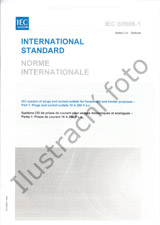Potřebujeme váš souhlas k využití jednotlivých dat, aby se vám mimo jiné mohly ukazovat informace týkající se vašich zájmů. Souhlas udělíte kliknutím na tlačítko „OK“.

IEC 61970-457-ed.2.0
Energy management system application program interface (EMS-API) - Part 457: Dynamics profile
Přeložit název
NORMA vydána dne 9.2.2024
Informace o normě:
Označení normy: IEC 61970-457-ed.2.0
Datum vydání normy: 9.2.2024
Kód zboží: NS-1166253
Počet stran: 1549
Přibližná hmotnost: 4678 g (10.31 liber)
Země: Mezinárodní technická norma
Kategorie: Technické normy IEC
Kategorie - podobné normy:
Anotace textu normy IEC 61970-457-ed.2.0 :
IEC 61970-457:2024 specifies a standard interface for exchanging dynamic model information needed to support the analysis of the steady state stability (small-signal stability) and/or transient stability of a power system or parts of it. The schema(s) for expressing the dynamic model information are derived directly from the CIM, more specifically from IEC 61970-302. The scope of this document includes only the dynamic model information that needs to be exchanged as part of a dynamic study, namely the type, description and parameters of each control equipment associated with a piece of power system equipment included in the steady state solution of a complete power system network model. Therefore, this profile is dependent upon other standard profiles for the equipment as specified in IEC 61970-452: CIM static transmission network model profiles, the topology, the steady state hypothesis and the steady state solution (as specified in IEC 61970-456: Solved power system state profiles) of the power system, which bounds the scope of the exchange. The profile information described by this document needs to be exchanged in conjunction with IEC 61970-452 and IEC 61970-456 profiles’ information to support the data requirements of transient analysis tools. IEC 61970-456 provides a detailed description of how different profile standards can be combined to form various types of power system network model exchanges. This document supports the exchange of the following types of dynamic models: • standard models: a simplified approach to exchange, where models are contained in predefined libraries of classes interconnected in a standard manner that represent dynamic behaviour of elements of the power system. The exchange only indicates the name of the model along with the attributes needed to describe its behaviour. • proprietary user-defined models: an exchange that would provide users the ability to exchange the parameters of a model representing a vendor or user proprietary device where an explicit description of the model is not described in this document. The connections between the proprietary models and standard models are the same as described for the standard models exchange. Recipient of the data exchange will need to contact the sender for the behavioural details of the model. This document builds on IEC 61970-302, CIM for dynamics which defines the descriptions of the standard dynamic models, their function block diagrams, and how they are interconnected and associated with the static network model. This type of model information is assumed to be pre-stored by all software applications hence it is not necessary to be exchanged in real-time or as part of a dynamics model exchange. This second edition cancels and replaces the first edition published in 2021. This edition constitutes a technical revision. This edition includes the following significant technical changes with respect to the previous edition: a) The majority of issues detected in IEC 61970-302:2018 and fixed in IEC 61970-302:2022 led to update of this document; b) IEEE 421.5-2016 on Excitation systems is fully covered; c) IEEE turbine report from 2013 was considered and as a result a number of gas, steam and hydro turbines/governors are added; d) IEC 61400-27-1:2020 on wind turbines is fully incorporated; e) WECC Inverter-Based Resource (IBR) models, Hybrid STATCOM models and storage models are added; f) The user defined models approach was enhanced in IEC 61970-302:2022 adding a model which enables modelling of a detailed dynamic model. This results in the creation of two additional profiles in this document. These are the Detailed Model Configuration profile and Detailed Model Parameterisation profile; g) A model to enable exchange of simulation results was added in IEC 61970-302:2022. This results in the creation of two additional profiles in this document. These are the Simulation Settings profile and Simulation Results profile; h) The work on the HVDC models is not complete. The HVDC dynamics models are a complex domain in which there are no models that are approved or widely recognised on international level, i.e. there are only project-based models. At this stage IEC 61970-302:2022 only specifies some general classes. However, it is recognised that better coverage of HVDC will require a further edition of this document as well as next edition of IEC 61970-302; i) Models from IEEE 1547-2018 "IEEE Standard for Interconnection and Interoperability of Distributed Energy Resources with Associated Electric Power Systems Interfaces" are added. j) Statements have been added to certain figures, tables, schemas, and enumerations throughout the document that indicate that they are reproduced with the permission of the UCA International User Group (UCAIug). These items are derived from the Common Information Model (CIM). IEC 61970-457:2024 specifie une interface normalisee pour l’echange des informations de modeles dynamiques, necessaires pour soutenir l’analyse de la stabilite en regime etabli (stabilite en petits signaux) et/ou la stabilite transitoire d’un systeme electrique ou des parties de celui ci. Le ou les schemas d’expression des informations de modeles dynamiques sont deduits directement du CIM, plus specifiquement de l’IEC 61970-302. Le domaine d’application du present document inclut uniquement les informations des modeles dynamiques qu’il est necessaire d’echanger comme partie integrante d’une etude des regimes dynamiques, a savoir le type, la description et les parametres de chaque equipement de commande associe a un equipement de systeme electrique inclus dans la solution permanente d’un modele exhaustif de reseau electrique. Par consequent, ce profil depend des autres profils normalises pour les equipements comme cela est specifie dans l’IEC 61970-452: Profils du modele de reseau de transport statique CIM, la topologie, l’hypothese en regime etabli et la solution en regime etabli (comme cela est specifie dans lIEC
Odebírejte informace o nově vydaných normách ZDARMA:
Chcete pravidelně odebírat informace o nově vycházejících normách z celého světa a to zcela zdarma?
Přihlašte se k odběru. Vše je velice jednoduché a absolutně ZDARMA.
Na výběr máte vydavatele z celého světa.



 Cookies
Cookies
